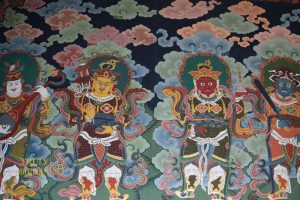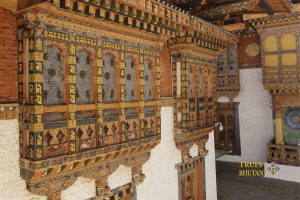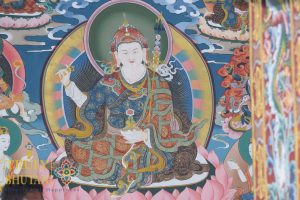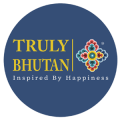It is believed that Bhutan was inhabited as early as 2000 B.C. due to the presence of early stone implements discovered in the region.
The country was originally known by many names including Lho Jong, ‘The Valleys of the South’, Lho Mon Kha Shi, ‘The Southern Mon Country of Four Approaches’, Lho Jong Men Jong, ‘The Southern Valleys of Medicinal Herbs, and Lho Mon Tsenden Jong, ‘The Southern Mon Valleys where Sandalwood Grows’. Mon was a term used by the Tibetans to refer to Mongoloid, non-Buddhist peoples that populated the Southern Himalayas.
The country came to be known as Druk Yul or The Land of the Drukpa sometime in the 17th century. The name refers to the Drukpa sect of Buddhism which has been the dominant religion in the region since that period.
Initially, Bonism was the dominant religion in the region that would come to be known as Bhutan. Buddhism was introduced in the 7th century by the Tibetan King Songtsen Gampo and further strengthened by the arrival of Guru Rinpoche, a Buddhist Master that is widely considered the Second Buddha.

The country was first unified in the 17th century by Zhabdrung Ngawang Namgyel. After arriving in Bhutan from Tibet, he consolidated his power, defeated three Tibetan invasions, and established a comprehensive system of law and governance. His system of rule eroded after his death and the country fell into fighting and civil war between the various local rulers. This continued until the Trongsa Penlop Ugyen Wangchuck was able to gain control and with the support of the people establish himself as Bhutan’s first hereditary King in 1907. His Majesty Ugyen Wangchuck became the first Druk Gyalpo (Dragon King) and set up the Wangchuck Dynasty that still rules today.
In 2008, Bhutan enacted its Constitution and converted it into a democracy to better safeguard the rights of its citizens. Later in November of the same year, the currently reigning fifth Druk Gyalpo Jigme Khesar Namgyel Wangchuck was crowned.
Bhutan Ethnicity
Bhutanese people can be generally categorized into three main ethnic groups. The Tshanglas, Ngalops and the Lhotshampas.
Bhutan’s population can be called in many ways, one large family. Living in scattered sparsely populated villages of the Himalayas’ rugged terrain, more than 70 percent of the people live on subsistence farming. Rice is the staple diet in the lower regions, and wheat, buckwheat, and maize are in other valleys. Farming is done in narrow terraces cut into steep hill slopes.
Bhutanese communities settled in the valleys with limited communication in the past. This factor led to the development of a strong sense of individuality and independence, which is an innate characteristic of the people. It is because of the very same reason that Bhutan has developed several languages and dialects, despite its very small population. Physically strong and fiercely independent by nature, Bhutanese are open-minded people with a ready sense of humor. Hospitality is an inbuilt social value in Bhutan.
The other minority groups are the Bumthaps and the Khengpas of Central Bhutan, the Kurtoeps in Lhuentse, the Brokpas, and the Bramis of Merak and Sakteng in eastern Bhutan, the Doyas of Samtse, and finally the Monpas of Rukha villages in Wangduephodrang. Together the multiethnic Bhutanese population number just over 700,000.
Tshangla
The Tshanglas or the Sharchops as they are commonly known, are considered the aboriginal inhabitants of eastern Bhutan. Tshanglas are according to historians, the descendants of Lord Brahma and speak Tsanglakha. They are common inhabitants of Mongar, Trashigang, Trashiyangtse, Pemagatshel, and Samdrup Jongkhar. Besides the cultivation of maize, rice, wheat, barley, and vegetables, the Tshanglas also rear domestic animals to supplement their living. Weaving is a popular occupation among their women and they produce beautiful fabrics mainly silk and raw silk.
Ngalop
The Ngalops who have settled mostly in the six regions of western Bhutan are of Tibetan origin. They speak Ngalopkha, a polished version of Dzongkha, the national language of Bhutan. Agriculture is their main livelihood. They cultivate cereals such as rice, wheat, barley, and maize along with a variety of other crops. In the regions of Thimphu and Paro, apples are also cultivated as a cash crop. They are known for Lozeys or ornamental speech and for Zheys, dances that are unique to the Ngalops.
Lhotshampas
The Lhotshampas have settled in the southern foothills of the country. It is believed that they migrated from Nepal at the beginning of the 19th century, attracted by the employment opportunities provided by the many constructions works taking place in the kingdom. They speak Lhotshampa (Nepali) and practice Hinduism. Their society can be broken into various lineages such as the Bhawans, Chhetris, Rai, Limbus, Tamang, Gurung, and Lepcha. Nowadays they are mainly employed in agriculture and cultivate cash crops like ginger, cardamom, and oranges.
The Bumthaps, Mangdeps & Khengpas
The people who speak Bumtapkha, Mangdepkha, and kheng Kha respectively inhabit the central areas of Bhutan. The Bumthaps cultivate buckwheat, potatoes, and vegetables. A section of this population also rears yaks and sheep and produces fabrics of wool and yak hair. The Mangdeps depend on the cultivation of rice, wheat, maize, vegetables, etc. besides rearing domestic animals. The khengpas are also dependent on agriculture much like the Mangdeps; however, they are also known for the bamboo and cane craft.
Kurtoep
Kurtoeps inhabit the eastern part of the country. Specifically, the district of Lhuentse and the villages are found spread along the banks of Kurichu. Khoma women are expert weavers and are known for their skill in weaving the grandiose Kushuthara.
The Brokpas & The Bramis
The Brokpas and the Bramis are semi-nomadic communities. They are settled in the two villages of Merak and Sakteng in eastern Bhutan. They mostly depend on yaks and sheep for their livelihood and do not typically grow crops due to the high altitude zones they inhabit. They speak a different dialect and have a unique dress that is made of yak hair and sheep wool. They are also experts in cane and bamboo crafts.
The Layap
To the extreme north is the Layap who speak layapkha. Like the Brokpas, they are semi-nomadic and their livelihood is dependent upon yaks and sheep. They use the products of their herd animals to barter rice, salt, and other consumables with the people of Wangduephodrang and Punakha.
The Doyap
A tribal community that has settled mostly in southern Bhutan. They are considered the aboriginal inhabitants of western and central Bhutan, who over the years migrated to and settled in the present areas in Dorokha. They have their unique dialect and style of dress.
Monpas
The Monpas are a small community in Rukha under Wangduephodrang. Together with the Doyas, they are also considered the original settlers of central Bhutan. They have their unique dialect but it is unfortunately slowly dying out as they are now being absorbed into the mainstream Bhutanese society.
RELIGION in Bhutan
The Bhutanese constitution guarantees freedom of religion and citizens and visitors are free to practice any form of worship so long as it does not impinge on the rights of others. Christianity, Hinduism, and Islam are also present in the country
BUDDHISM
Bhutan is a Buddhist country and people often refer to it as the last stronghold of Vajrayana Buddhism. Buddhism was first introduced by the Indian Tantric master Guru Padmasambhava in the 8th century. Until then the people practiced Bonism a religion that worshipped all forms of nature, remnants of which are still evident
Until then, the people practiced Bonism a religion that worshipped all forms of nature, remnants of which are still evident even today in some remote villages in the country.
With the visit of Guru Padmasambhava, Buddhism began to take firm roots within the country and this especially led to the propagation of the Nyingmapa (the ancient or the older) school of Buddhism.

Phajo Drugom Zhigpo from Ralung in Tibet was instrumental in introducing yet another school of Buddhism – the Drukpa Kagyu sect. In 1222, he came to Bhutan, an event of great historical significance and a major milestone for Buddhism in Bhutan, and established the Drukpa Kagyu sect of Buddhism, the state religion. His sons and descendants were also instrumental in spreading it to many other regions of western Bhutan.

By far the greatest contributor was Zhabdrung Ngawang Namgyal. His arrival in 1616 from Tibet was another landmark event in the history of the nation. He brought the various Buddhist schools that had developed in western Bhutan under his domain and unified the country as one whole nation-state giving it a distinct national identity.
The Buddhism practiced in the country today is a vibrant religion that permeates nearly every facet of the Bhutanese lifestyle. It is present in the Dzongs, monasteries, stupas, prayer flags, and prayer wheels that punctuate the Bhutanese landscape. The chime of ritual bells, the sound of gongs, people circumambulating temples and stupas, fluttering prayer flags, red robed monks conducting rituals stand as testaments to the importance of Buddhism in Bhutanese life.
Animism
For example, mountain peaks were considered the abodes of guardian deities (Yul Lha), lakes were inhabited by lake deities (Tshoem), cliff deities (Tsen) resided within cliff faces, the land belonged to subterranean deities (Lue and Sabdag), water sources were inhabited by water deities (Chu gilhamu) and dark places were haunted by the demons (due).
Every village has a local priest or a shaman to preside over the rituals. Some of the common forms of nature worship being practiced are the Cha festival in Kurtoe, Kharphud in Mongar and Zhemgang, Bala Bongko in Wangduephodrang, Lomba of the Haaps and Parops, Jomo Soelkha of Brokpas, Kharam amongst Tshanglas and Devi Puja amongst our southern community.
These shamanistic rituals are performed for various reasons ranging from keeping evil spirits at bay, bringing in prosperity, curing a patient, or welcoming a new year. A common feature in all of these rituals is the sacrifice of animals like oxen, fish, chickens, or goats.
Bhutanese Society
Bhutanese society is free of class or a caste system. Slavery was abolished by the Third King Jigme Dorji Wangchuck in the early 1950s through a royal edict. However, a few organizations to empower women were established in the past Bhutanese society has always maintained relative gender equality. In general, our nation is an open and good-spirited society.
Living in Bhutanese society generally means understanding some accepted norms such as Driglam Namzha, the traditional code of etiquette. Driglam Namzha teaches people a code of conduct to adhere to as members of a respectful society. Examples of Driglam Namzha include wearing a traditional scarf (kabney) when visiting a Dzong or an office, letting the elders and the monks serve themselves first during meals, offering felicitation scarves during ceremonies such as marriages and promotions and politely greeting elders or seniors.
Normally, greetings are limited to saying “Kuzuzangpo” (hello) amongst equals. For seniors and elders, the Bhutanese bow their heads a bit and say “Kuzuzangpo la” (a more respectful greeting). Recently, shaking hands has become an accepted norm.
The Bhutanese are fun-loving people fond of song and dance, friendly contests of archery, stone pitching, traditional darts, basketball, and football. We are a social people that enjoy weddings, religious holidays, and other events as the perfect opportunities to gather with friends and family.
The openness of Bhutanese society is exemplified in the way our people often visit their friends and relatives at any hour of the day without any advance notice or appointment and still receive a warm welcome and hospitality.
Culture & Tradition in Bhutan
Bed-rocked on religious teachings, Bhutanese culture has stood the test of time. Everything about Bhutanese culture is steeped in tradition, starting from language and literature to the arts and crafts, ceremonies and events, and basic social and cultural values. Very much alive and breathing, the Bhutanese culture of fine arts, for instance, is manifested, for example, in exquisite traditional paintings visible on monasteries and houses, skillfully enhancing the architecture.
Architecture, which is another symbol of Bhutanese identity, is also a core aspect of the kingdom’s unique culture. Blending engineering skill and aesthetic beauty, architectural wonders, beginning from the massive and majestic monastic fortresses to houses and bridges are seen. Bhutanese architecture is in a class of its own with traditional shapes, colors, and patterns on the walls, doors, and windows.
Religious festivals, called Tsechus, are also at the core of Bhutan’s culture. Comprising music and dance, which is performed both by the clergy and the lay population, Tsechus plays an important role in the lives of every Bhutanese, both at the local and national levels.
Meanwhile, Bhutan’s textile tradition has, in recent years, gone international, with the distinct technique, color, and style of indigenous Bhutanese weaving increasingly catching the eyes of textile specialists, collectors, and users.
While Bhutan’s national language is Dzongkha, there are more than 18 dialects spoken across the country. However, English, which is used as the official working language, is taught in schools. In recent times, there has been a surge in the emphasis on the development and use of Dzongkha.
BHUTANESE DRESS
One of the most distinctive features of the Bhutanese is their traditional dress.
One of the most distinctive features of the Bhutanese is their traditional dress, unique garments that have evolved over thousands of years. Men wear the Gho, a knee-length robe somewhat resembling a kimono that is tied at the waist by a traditional belt known as Kera. The pouch that forms at the front traditionally was used for carrying food bowls and a small dagger. Today however it is more accustomed to carrying small articles such as wallets, mobile phones, and Doma (beetle nut).
Women wear the Kira, a long, ankle-length dress accompanied by a light outer jacket known as a Toego with an inner layer known as a Wonju.
However, tribal and semi-nomadic people like the Bramis and Brokpas of eastern Bhutan generally wear clothing that differs from the rest of the Bhutanese population. The Brokpas and the Bramis both wear dresses woven either out of Yak or Sheep hair.
Bhutanese still wear long scarves when visiting Dzongs and other administrative centers. The scarves worn vary in color, signifying the wearer’s status or rank. The scarf worn by men is known as Kabney while those worn by women are known as Rachu. Below is a brief breakdown of the different kabney and their associated rank.
The Rachu is hung over a woman’s shoulder and unlike the scarves worn by men, does not have any specific rank associated with its color. Rachu is usually woven out of raw silk and embroidered with beautiful rich patterns.
Rank | Kabney/Scarf |
| The King | Yellow |
| Je Khenpo (Chief Abbot) | Yellow |
| Minister of Bhutan | Orange |
| Judges of Bhutan | Green |
| Governor of Bhutan | Red with a small white stripe |
| Commoner of Bhutan | White |
Bhutanese Birth Element
The birth of a child is always welcomed. In Bhutan, extended family and guests are discouraged from visiting during the first three days after the birth.
On the third day, a short purification ritual is performed after which visitors are welcomed to visit the newborn and mother. Bhutanese value children as progenitors of the future and therefore do not discriminate on the sex of the child. Traditionally various gifts are offered ranging from dairy products to cloth and money.
The child is not immediately named; this responsibility is usually entrusted to the head lama (Buddhist priest) of the local temple. The mother and child will also receive blessings from the local deity (natal deity) and it was traditional that the name associated with the deity is given. In some cases, the child is given the name of the day on which the child is born. Based on the Bhutanese calendar, a horoscope is written based on the time and date of the birth, this will detail the various rituals to be performed at different times in the life of the child and to an extent predict his or her future.
EATING HABITS in Bhutan
Traditional Bhutanese eating habits are simple and, in general, food is eaten with hands. Family members eat while sitting cross-legged on the wooden floor with food first being served to the head of the household.
It is usually women who serve the food and in most cases, the mother. Before eating, a short prayer is offered and a small morsel is placed on the floor as an offering to the local spirits and deities. With modernization, eating habits have changed and in urban areas, people usually eat with cutlery whilst seated at a regular dining table.
Traditionally dishes were cooked in earthenware, but with the easy availability of modern goods, pots and pans have largely replaced their use. A typical Bhutanese meal consists of rice, a dish of Ema Datshi, the country’s favorite dish of chili and cheese, pork, beef curry, or lentils.
Death & Funeral Rites in Bhutan
Death signifies rebirth or a mere passing on to a new life. In keeping with the traditions, elaborate rituals are performed to ensure a safe passage and a good rebirth.
The 7th, 14th, 21st, and 49th days after a person’s death are considered especially important and are recognized by erecting prayer flags in the name of the deceased and performing specific religious rituals. While the deceased are normally cremated, funerary practices vary among the southern Bhutanese and the nomadic Brokpas of northern Bhutan. Southern
Bhutanese typically bury their dead while the Brokpas carry out ‘Sky Burials’, a process in which the deceased are prepared and left atop mountains to be devoured by vultures in a final act of compassion and generosity. Elaborate and ancient rituals are also conducted on the anniversary of the death with the erection of prayer flags. The relatives and people of the locality come with alcohol, rice, or other sundry items to attend such rituals.
Marriage Laws of Bhutan
Until just a few decades, ago arranged marriages were common and many married among their relatives. In eastern Bhutan cross-cousin marriages were also once common, however, this practice is now becoming less commonplace among the literate masses and most marriages are based on the choice of the individuals.
Marriages are simple affairs and are usually kept low-key. However, elaborate rituals are performed for lasting unions between the bride and the bridegroom. As the religious ceremony ends, parents, relatives, and friends of the couple present the newlyweds with traditional offerings of scarves along with gifts in the form of cash and goods.
In Western Bhutan, it was commonplace that the husband goes to live in his wife’s house after marriage while the practice in Eastern Bhutan is for the wife to move into the husband’s home. Of course, the newlyweds may also choose to live on their own. Divorce is also an accepted norm and carries no ignominy or disgrace within the country.
Folk Music & Dance of Bhutan
In all the Himalayas, the ancient dances of the region have been most faithfully preserved in Bhutan. The extraordinary grace and color of these energetic, dramatic dances are one of the visitor’s most vivid memories. To the fanfare of trumpets and the rhythmic sounds of drums, cymbals, pipes, and gongs, a rainbow of dancers whirls and bends and leaps high in the air with Skirts swirling and hands moving in the timeless gestures that correspond to the mudras and Buddhist rites.
Folk songs and dances from the corners of the kingdom are rich and varied. The Bhutanese are a musical people. Folk songs of an itinerant minstrel, the low chanting of the monks, the sounds of long horns echoing across the valley, lively processions, scared dances, and ancient folk dramas re-enacted are all a part of the intriguing pastiche of Bhutanese music.
